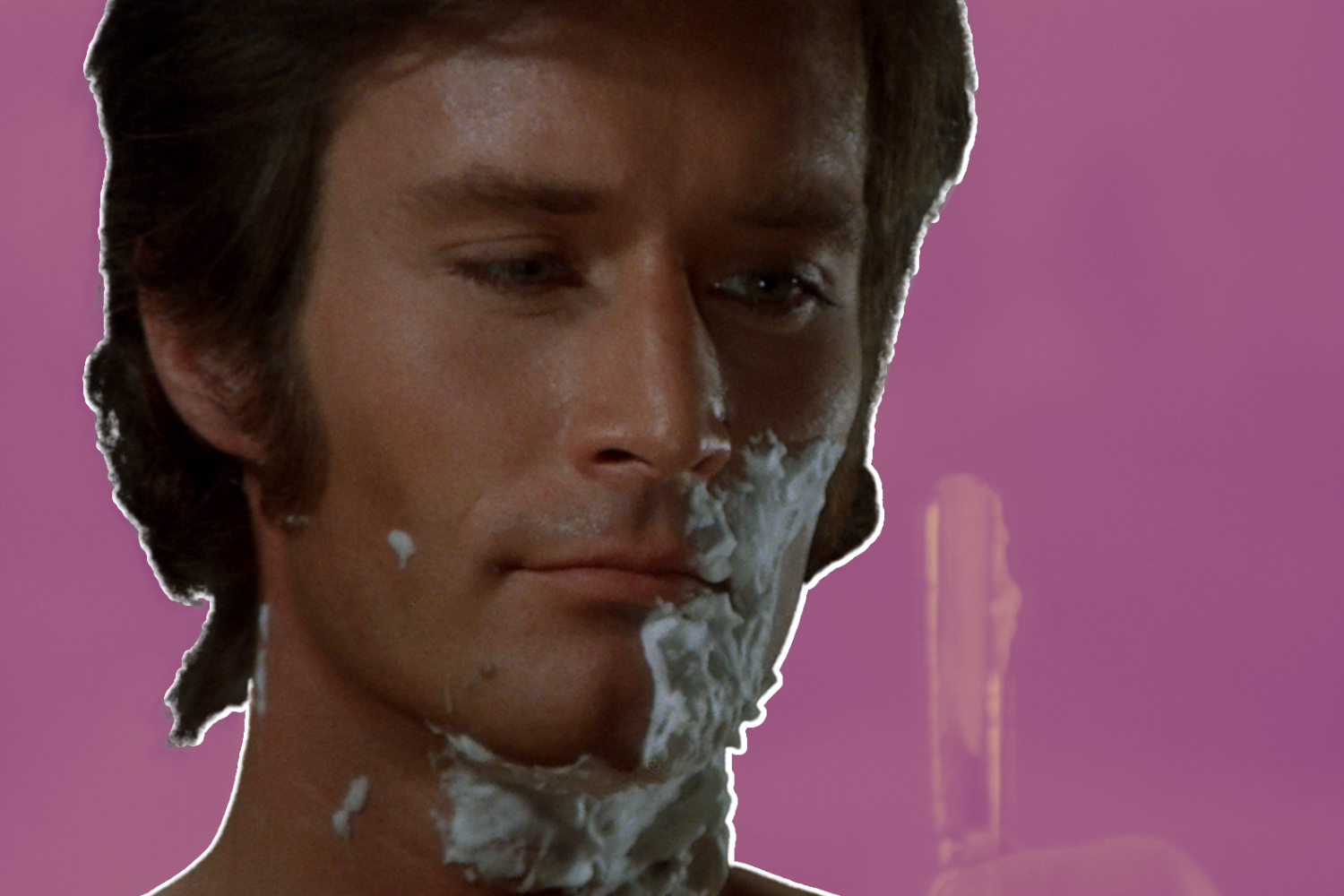Editorials
‘Bandh Darwaza’ Brought Horror to Bollywood
April 5th, 2021 | By Wally Adams
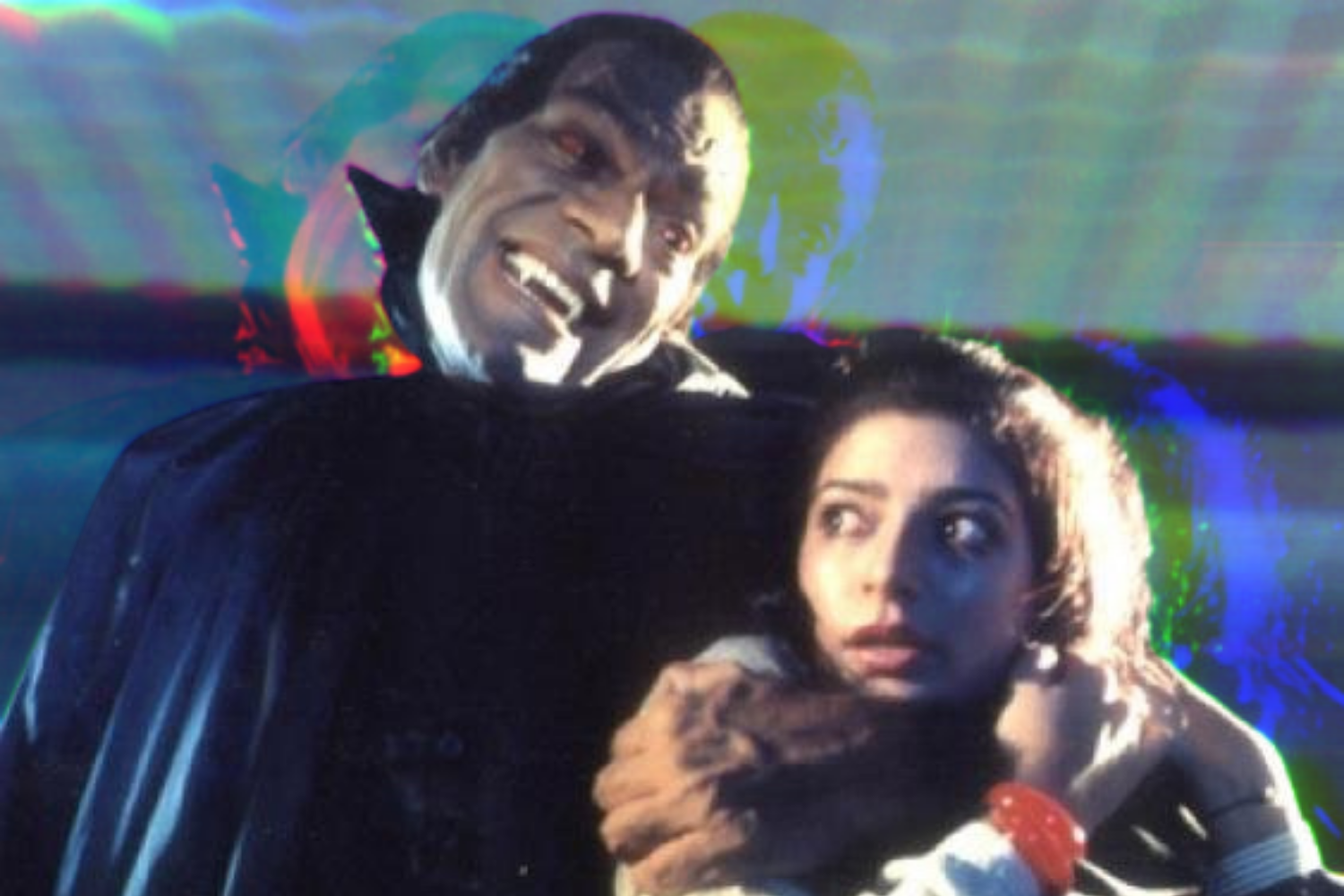
Popularized in the 1970s but reaching peak industry dominance through the 1980s and 90s, the often-lavish masala genre dominated Bollywood over three decades. During this time—in remarkably parallel fashion to how Hollywood operated in the 1980s—production periods and costs had become so high that normal and smaller-size projects were severely sidelined. That often left room for only the biggest of the big and the cheapest of the cheap. It had become a regular thing for Bollywood movies to run near or over three hours long and take an entire year to make, with masala films aiming to provide a total package of drama, comedy, romance, action and musical.
One thing there wasn’t room for in Bollywood was horror like Bandh Darwaza—an almost completely foreign concept to Indian audiences literally and figuratively as a pure genre (not counting the older, gently romantic ghost stories the industry pioneered with 1949’s Mahal). That changed when seven brothers from Karachi were brought to Mumbai by their father (upon Partition). In a remarkable family affair, the Ramsay Brothers played a near-total part in making their films and for a time, essentially ran the nation’s whole horror genre. The eldest Tulsi and Shyam (the overall head of the group) directed; Keshu produced; Kumar wrote the scripts; Gangu did the camerawork; Kiran handled the sound; and Arjun did the editing.
The Rarity of Bollywood Horror
After a string of failures in the early part of their career, in 1971 the brothers decided to try something very different with Do Gaz Zameen Ke Neeche, Bollywood’s first pure horror film. While Neeche got the ball rolling with a cult following (aptly enough), it was 1984’s Purana Mandir (The Ancient Temple) that became a milestone that shocked not only throngs of viewers with its demons, curses, possessions, blood and sexuality, but the entire industry as well. Why? Because a low-budget shlock movie with a C-list-and-below cast and an “Adults Only” certificate—which normally would’ve been three strikes against a movie’s commercial prospects—beat mega-productions with the biggest stars to become the #2 box office hit of the year by a budget-to-earnings ratio.
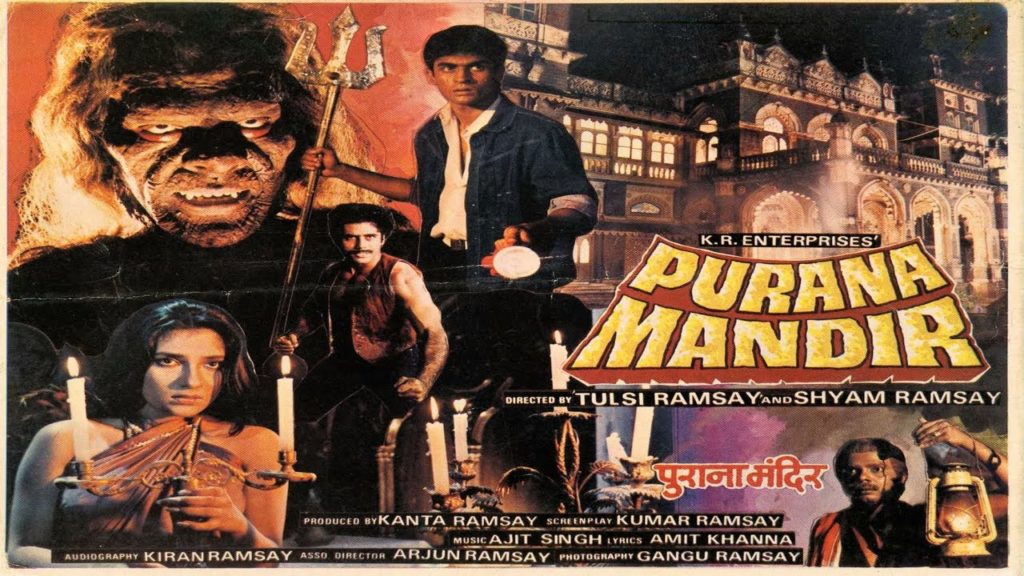
While Purana Mandir marked the Ramsays’ peak popularity, the brothers made almost nonstop hits in the genre for two decades. How’d they do it? Shyam cited the four key ingredients of the Bollywood horror movie as follows: “sex, drama, good-looking girls and fear.” That he mentioned fear last wasn’t indicative of it being the least important factor. On the contrary, it’s that extra oomph factor that makes the genre special and different from everything else. Just like the actual masala spices added as the final ingredient to otherwise routine cuisine, fear gave these films a character all their own.
Under normal circumstances, a movie of a new type (or especially a sequence of movies) having unprecedented success in its industry would inevitably result in massive newfound interest and offers from big studios and names. But the industry at large still thought the genre too alien and lowbrow. (To put things into perspective for how odd the genre seemed, the censor board attached messages at the beginning of some Ramsay films warning viewers not to try practicing black magic after seeing them.) There was just a brief wave of ultra-cheap copycat independent horror movies during the few years of the Ramsays’ peak success, with the only such director even reaching footnote status being Mohan Bhakri (whose movies were even wilder but not as well-made).
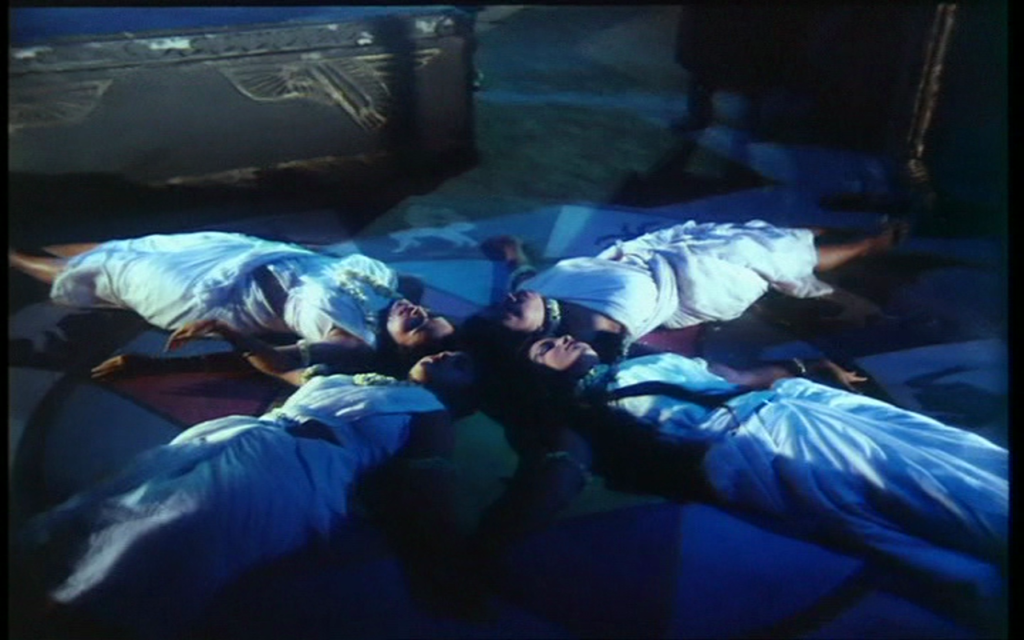
Thus, you would never see Bollywood’s top stars of the 80s and early 90s like Aamir Khan or Sanjay Dutt in Ramsay Brothers films. It was even more out of the question for female superstars like Sridevi or Jaya Prada, as being in such “tawdry” films—where women in either really loose, tight and/or skimpy clothes would get stalked, attacked, possessed and/or killed in rather similar fashion to many 80s American horror movies—could ruin their reputation. So it’s no coincidence that many of the female stars of the Ramsays’ movies stayed on the “underground” side of the industry. And a few, like the especially pneumatic lead of 1988’s T&A-filled Veerana, Jasmin, would never have major or any roles after their Ramsay film(s).
Breaking Out With Bandh Darwaza
But 1990’s Bandh Darwaza (“The Closed Door”) was made during the time of the brothers’ highest industry clout. That allowed them to cast their largest C-list assortment of character actors, TV actors, stars from regional cinema (like “Kollywood” and “Tollywood”), and older stars past their prime. And this time, the actresses were better known too. That probably helps to explain why the filmmakers were on their best behavior; which still wasn’t too behaved, but at least meant holding back on the “funnier” outfits, shots and songs for the actresses.
Lajo lives in a haveli (traditional South Asian palatial house) with her landlord husband, Pratap Singh (Vijayendra Ghatge). Not far off from their house is Black Mountain, known and feared for its satanic rituals and “toying with the honor of women and leading their daughters into shame”. But for now, Pratap is more worried about his aunt, who keeps pestering him to find a way to carry on the family line while putting down Lajo for her infertility. After auntie goes as far as moving to setPratap up with a young “professional” girl to have his child, an eavesdropping Lajo is devastated.
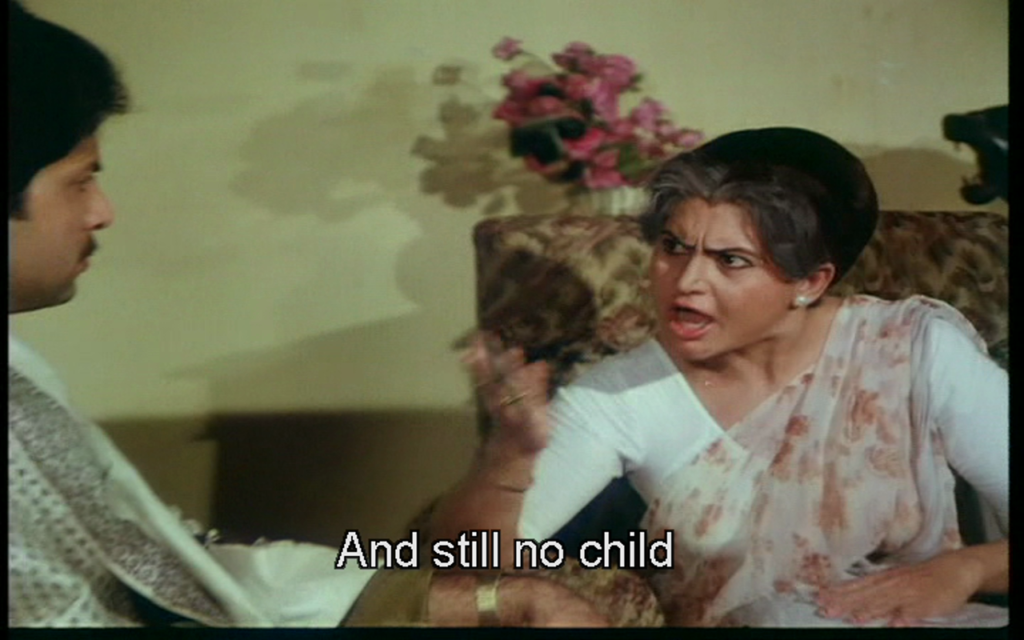
That’s where their mysterious maid Mahua (Aruna Irani) steps in. Mahua warns Lajo that her only chance to bear a child is to secretly come to Black Mountain and meet their master—Neola (Anirudh Agarwal)—who’s supernaturally fertile, as normally, “flowers can’t grow in a bed of sand” (an example of Ramsay dialogue that straddles somewhere between crude and poetic). Desperate, Lajo doesn’t seem to pay attention to the condition of her “contract” when she agrees: if it’s a boy, they can keep it. But if it’s a girl, she’ll belong to Black Mountain. It’s a girl, yet Lajo doesn’t keep her promise and is killed for it; Pratap in turn kills Neola.

Fast-forward 18 years (or 1 minute past the credits, as everything before was just the intro): Lajo’s daughter Kaamya (Kunika) is all grown up now. And despite being the offspring of a vampire belonging to a cursed place, the only thing that seems demonic or possessed about Kaamya is her sex drive, as she can no longer resist relentlessly putting moves on her childhood friend, Kumar (Hashmat Khan). Unfortunately, Kumar only has feelings for Bombay girl Sapna (Manjeet Kullar), deeply hurting Kaamya with rejection. Thus Black Mountain continues being the bane of the family’s existence, seizing its chance to make a new deal with the now-all-too-willing Kaamya to use a cursed mantra to bewitch Kumar into falling for her. Worse yet, Neola is reborn far more powerful than last time.
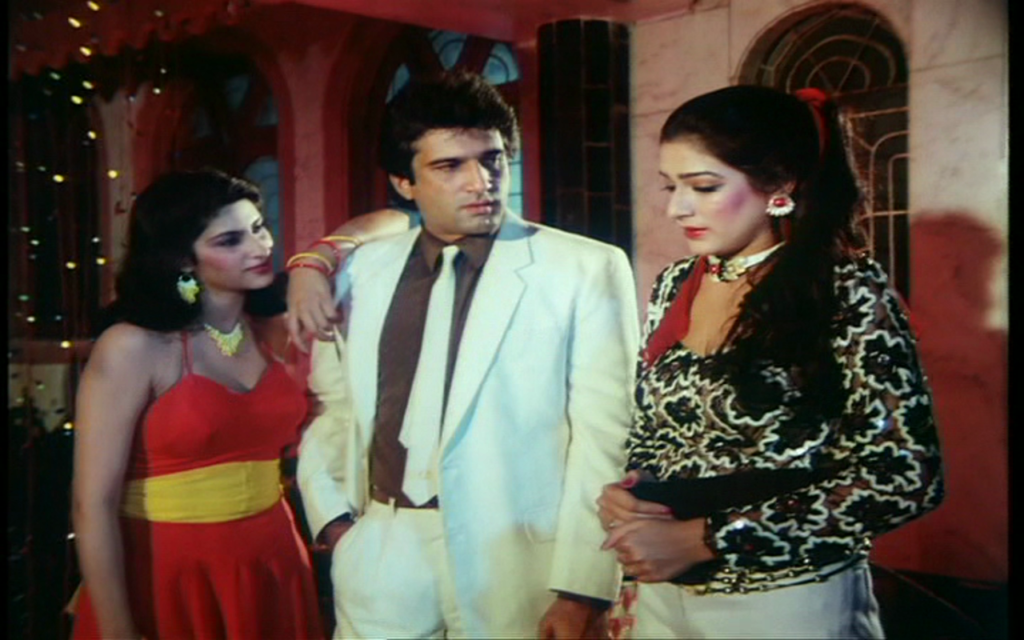
Derivatively Distinct Cinema
Bandh Darwaza highlights all of the Ramsay’s unique collective talents. In basic themes, they drew inspiration from classic Hollywood horror canon like Dracula, The Exorcist (Shyam’s favorite), and The Omen. But stylistically, the brothers’ quite impressive knack with elaborately designed gothic sets (with Tulsi doing set design on some films and T.K. Desai on later ones) that belied their budgets and the slow, brooding way the camera moved around them seem most inspired by Mario Bava. The location shooting and setups for well-chosen eerie places (ancient temples, castles, forests) replete with added fog effects and intensifying music is more redolent of Hammer Studios.
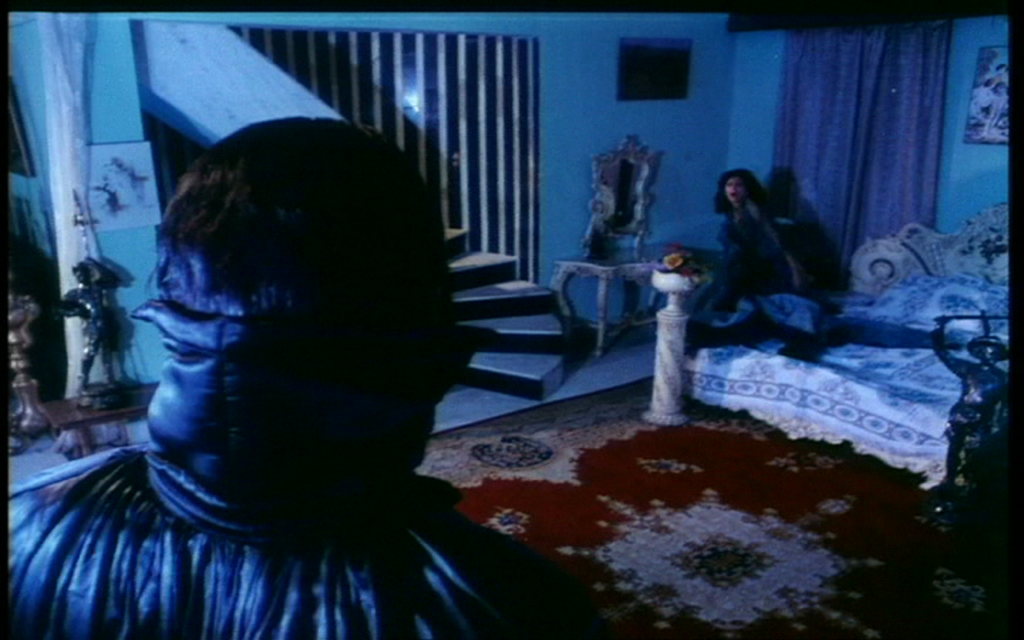
But the brothers didn’t just copy, as the other crucial half of their gift was richly imbuing a distinct Indian flavor to their tales and designs, transcribing Indian mythology and spirituality to their sense of the supernatural. As Hinduism already has and in fact started some of the richest concepts in reincarnation, karmic retribution, and more plainly laid out presences of ghosts and demons, some of the more occult varieties made a natural fit for Ramsay films. (Other times—as with graveyards which Indians don’t tend to need—it was necessary to use other religious templates). They also worked from a wholly different cultural and societal framework, with villagers, landowners, arranged (and forbidden) marriages, princes, and princesses you’d seldom find in present-day Western horror movies.
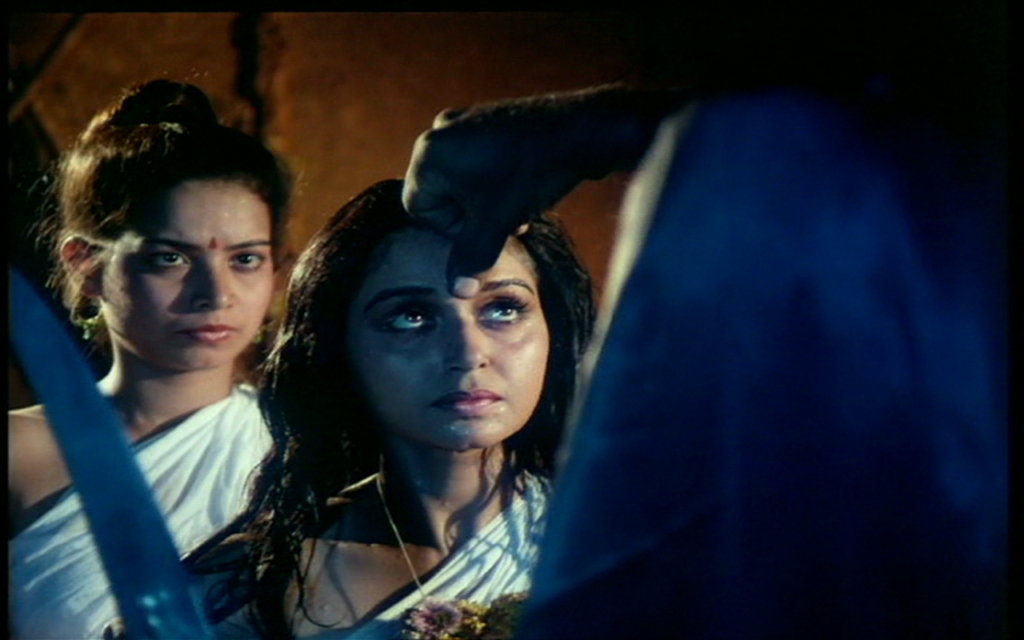
Beyond comedic incidental scenes (including some lengthy ones that somewhat marred the tone of earlier Ramsay movies) and provocative dances, many central plot points and twists in the Ramsays’ films indeed involved sex (before/during/after): marital, casual, charms and curses around it, childbirth and demonbirth. These could come in the form of eerie yet also wacky developments (when Kumar becomes possessed to follow Kaamya, she directs him in the dead of night to have sex in the graveyard), or stylistic flourishes (Neola throwing his cape over Lajo and himself before consummating their demonic deal of a relationship).
With that in mind, the Ramsays had to fight with some of the most bizarre and seemingly erratic censorship rules in the world (which is no small feat against competition like the MPAA and BBFC). For example, on this “Adult” film it was deemed acceptable to have Kumar kissing on Kaamya’s breasts, but not showing them kissing on the lips (the camera takes a special angle so that Kaamya’s hair obscures their lip locking). But generally, Bandh Darwaza was able to get away with more (including extreme violence, kissing, slightly obscured/very clearly implied sex and affairs, lingering T&A etc.) than even other Bollywood films with “Adult” certificates.
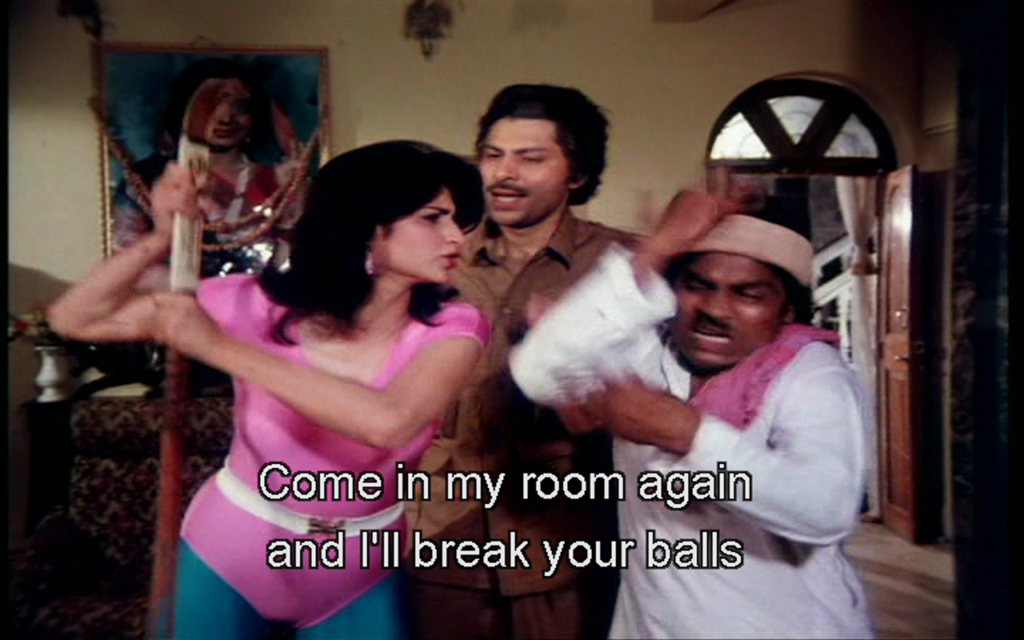
I suspect a reason for this was because the CBFC (Censor Board of Film Certification) thought very little of these movies and their genre. Therefore, they figured most people even coming to see the films were uncultured and wouldn’t be too offended or corrupted by a lot of content that normally would’ve been of concern.
The Ramsays’ Gallery of Rogues
Bandh Darwaza is largely cast with actors/actresses who specialized in villainous roles. Reza Murad (who plays an evil tantric priest) won several awards for his villains (and yes, most Bollywood award ceremonies had categories for villains). Kunika was known for vamp roles—literally, in the case of this film. And Irani is a true veteran of such roles and more, in over 500 movies and counting. But thanks to the Ramsays, our resident vampire Agarwal—the film’s MVP in story and performance despite having limited scenes and dialogue—was the only Indian star up to then who was ever typecast as monsters and demons beyond mere villains.

The Ramsays apparently didn’t get (or want) the memo regarding how far vampire civilization had come since the days of the hideous Nosferatu. The cultured, articulate and either cunningly evil or uncontrollably anguished vampires popular over half a century from Bela Lugosi to Christopher Lee, then Robert Quarry to Tom Cruise, won’t be found here. Nor are the hip, stylish, quite-similar-to-human Gen X vampires of Buffy or Blade. Least of all, there’s no sign of the youthful and curiously heartthrob/matinee idol vampires introduced in 1988’s The Lost Boys then exponentially cranked up over the years to (the wrong kind of) grotesque heights of Twilight.
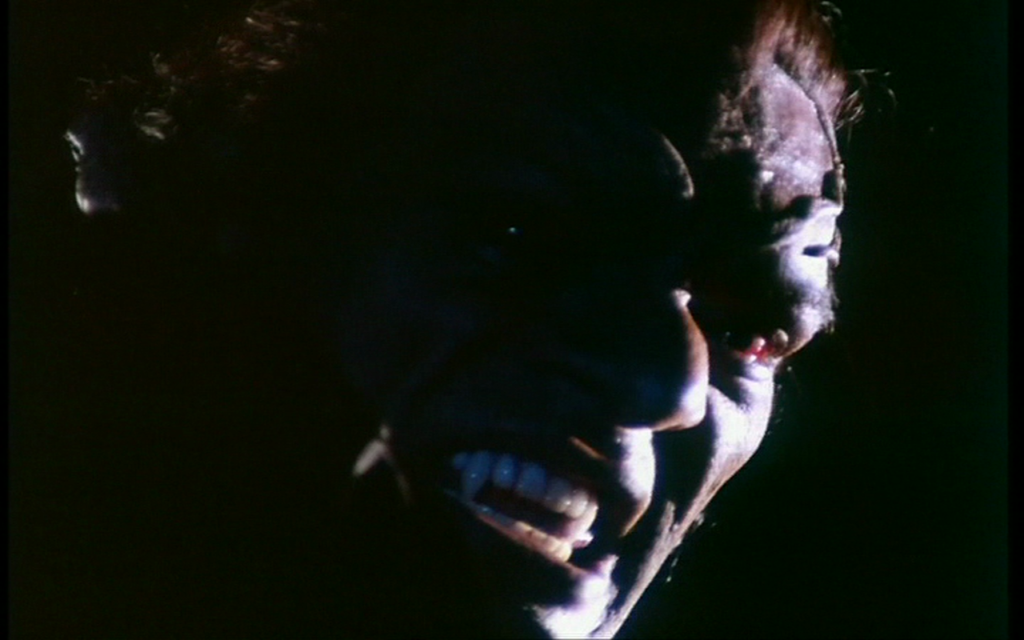
This vampire is a true creature of the night, with overpowering deep red eyes, a grim countenance, a foreboding, echoing baritone voice and a solemn, terse manner of speaking. In short, he’s genuinely scary and monstrous like fewer and fewer vampires have been over the last several decades. But he still also has a plain lust for power combined with a more distinctly Desi fixation about carrying on a line of demonic descendants—though this one actually prefers girls.
So even more so than biting women’s necks, Neola’s interested in necking with them (and more) so they can have his spawn. But it’s not just his demonic power and libido that makes this vampire truly scary; it’s also his apparent invincibility. This one is a product of centuries of evolved cultural mixing and different ruling classes, so it will take a heck of a lot more than a cross to merely faze him.

At one point, the heroes set a special trap to rout him that features a Cross, a Hindu Om and a Koran in tandem. Casually fitted into the story though it is, this cleverly quaint message is a defining example of how even within all the craziness of their films, the brothers still slipped in markedly progressive and socially conscious themes. In fact, those are even more relevant messages for today that could be learned from, with the pitiful directions Indian religious politics have been taking on multiple fronts that even stretch to the film industry itself.
The Monster Mash
The biggest of all names involved in the film for the time were actually composer duo Anand-Milind—who are brothers—for the soundtrack. While typically romantic or festive songs could easily disrupt the flow of such films, Bandh Darwaza brilliantly works within that system in ways that enhance rather than compromise the mood. One song seems like a typical “item number,” with Sapna dancing to arouse Kumar. But Kumar happens to be under the influence of Kaamya’s spell, so nightmarishly sexy visions of Kaamya beckoning him keep popping up in the middle of Sapna’s song.
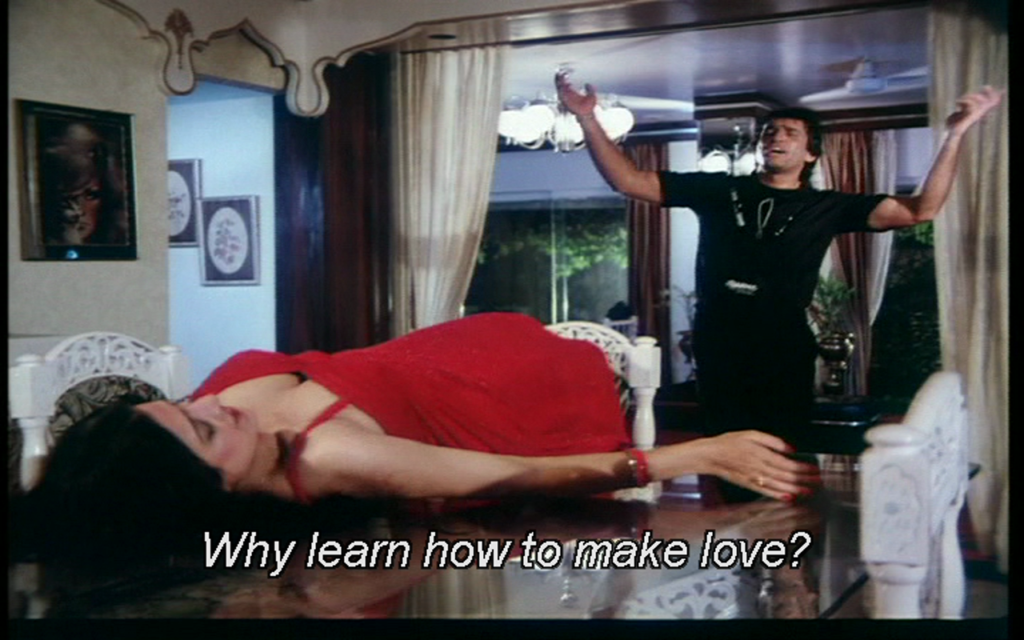
But aptly serving as the centerpiece of the film is the song “Main Ek Chingari Hoon” (“I Was Once a Spark”), with grimly poetic lyrics about being trapped, lovelorn and hopeless to a wistfully soothing melody. One verse is sung in a crescendo of desperation as Kaamya mopes through the dark and foggy corridors alternately in chains, under the menace of Neola, and as she’s desperately (yet rhythmically) back-crawling away from an approaching Mahua. So in the songs, the Ramsays proved just as adept at incorporating Western horror elements into distinctly Indian cinematic forms as they previously did Indian ones into Western forms. At their best then, the brothers were brimming with creativity that brought what were once two entirely different film worlds together.
Bandh Darwaza in many ways showcases the brothers’ talents at peak refinement with advances in resources, casting, message and style. So it’s a pity it would be their penultimate horror film as their industry luster began to fade, evident in the cold reception of their final effort, 1993’s Mahakaal (a rather ill-fitted remake of Nightmare on Elm Street). But in their last team outing, Tusli and Shyam would prove equally revolutionary for Indian TV, producing, directing, writing and presenting most of 1993’s The Zee Horror Show, similarly popularizing horror in that medium over an astonishing 9 years and 364 episodes.
The Ramsays were reasonably regarded as an utterly unique aberration for their industry during their time, as their period’s horror bubble would seem to totally burst like a fad. Yet tellingly, like the vampire Neola, the brothers’ legacy and their genre would come back many years later with a vengeance—ironically in a way far more prevalent and plainly seen than when they were active. (And though Tulsi and Shyam passed away in 2018 and 19 respectively, the pedigree still lives on, with Shyam’s daughter Saasha doing web and TV series including 2008’s Neeli Aankhen about a naagin or snake woman.)
The Post-Ramsay Subcontinent of Horror
The genre exponentially grew into an enduring presence since the turn of the 21st century. The first respected mainstream director to dedicate himself to horror for a time was Ram Gopal Varma—who had previously specialized in gangster movies—in the 1990s. The 2003 release of his protege Prawaal Raman’s groundbreaking horror anthology Darna Mana Hai fully ushered the genre into the mainstream, with intermittent star-studded horror extravaganzas like 2004’s Rakht (Blood) to come. Then there were the Bhatt brothers, director Vikram and producer Mukesh, who’d make the genre’s first popular franchise in Raaz (though they tended to rip Hollywood movies a little too directly.)
For the last decade, a recent trend sees horror films directly rooted in India’s folk traditions like 2018’s Stree and 2020’s Bulbbul, while the most recent Bollywood horror phenomenon was Ragini MMS, a bizarre adult-horror-comedy series about haunted MMS sex tapes. Most of those movies and directors have budgets and casts that the Ramsays and their contemporary audiences couldn’t have possibly dreamed of.
Yet they have not been able to surpass the overall edge, invention and formidable resourcefulness that powered the Ramsays perhaps as much out of necessity as out of skill and cleverness. Furthermore, the many who’ve finally embraced the genre unashamed now are unmistakably indebted to the Ramsays, following the path they had paved. That was a path which was far too dark, uncharted, and indeed scary for anyone to have tried taking before them.
Visit our Editorials page for more articles like this. Ready to support more original horror criticism? Join the Certified Forgotten Patreon community today.


